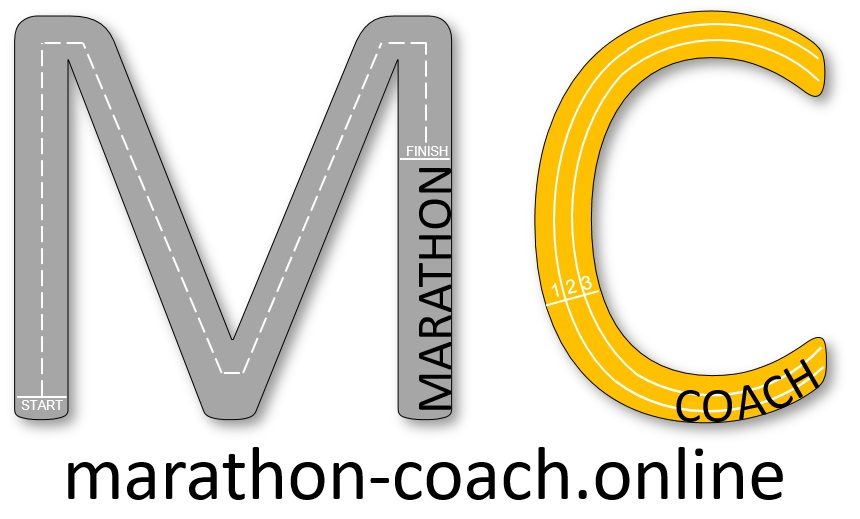Injuries
Runner injuries are always an important point of discussion between athletes and hamstring tear or proximal hamstring tendonitis are an usual injury. In other words, every athlete will have been through an injury period and it is always a tough mental time. Looking at the statistics, the majority of the injuries are between the knee and the foot. Above all, the top five injuries with runners are:
Patellofemoral Pain Syndrome (PFPS) – Runner’s Knee
IT band
The hamstring injury is the sixth most common injury for runners. It is more common for team sport like Soccer, but impact runners too.
The main causes of injuries are the increase in the training load too quickly and a previous injury. For instance, to avoid injuries, ensure you increase the load very progressively and if you get injured, get the physio to improve the situation and work on your rehabilitation up to the end of the treatment.
To lower risks of injuries, apart from the running, you should work on the drills before the speed sessions and add the following sessions: plyometric, hills reps, Strength and Conditioning.
Disclaimer concerning this article:
I give general advice based on my knowledge gained during my sport massage therapy course and readings. This article is not replacing the judgement of a doctor or a physiotherapist. Above all, ensure you visit your local doctor or therapist for a detail analysis of your injury.
What to do when you get an injury:
First, the most important is to stop your run / session. Do not run on an injury. Take a taxi, ask a drive back home or walk back. However, do not continue your run.
Secondly, when you are at home, you need to follow the PRICE treatment for the next fourty eight hours to seventy two hours until the inflammation is gone:
– Protect the area.
– Rest: avoid walking too much, do not do any sport. If the pain is very acute, use crutches.
– Ice: This is a bony area, then you should ice only for 5 minutes at a time. Ice three to five times per day. Use a cloth to avoid the ice to be in direct contact with the skin. For instance, if you have access to the sea, a cold river, you can use the natural water to cool down your full legs. Using ice cubes in a bathtub is an alternative.
– Compress: If there is inflammation of the knee, compress the area.
– Elevate: Ensure the knee is slightly bent. An advice is to put a cushion under the mattress and not directly under to feet.

Thirdly, get an appointment with your physio. The physio will be able to start the treatment after the inflammation.
Fourthly, if the physio cannot fully treat and the injury is very serious you need to go to your doctor or specialist. In conclusion, if the injury is serious, go straight to the doctor or to the emergency room of your local hospital.
Reminder
The physio will be able to improve the injury during your visit, but remember that the main improvements are going to come from you. Ensure you do all the exercises given by the physio.
Do not overdo because it can be counter-productive and bring further inflammation, but ensure you do not wait until next appointment to get the physio to improve the situation.
Hamstring injury:
The Hamstring injury is the sixth most common injury with athletes. In other words, the hamstring muscle can get a tear or the tendons on the top of the hamstring are getting inflammed. The proximal hamstring tendons connect the three hamstring muscles (the semimembranosus, the semitendinosus, and the biceps femoris) to the sit bone (ischial tuberosity), which is located in the buttocks at the bottom of the pelvic bone. Therefore, these injuries are common with sports with repetitive movements or by doing a sprint with muscles / tendons not warmed-up enough.
Tendon
Most of the time, for the tendon, the pain is at the top of the hamstring and more important when you are seating for long periods.
Muscle
For muscle injury, the pain may come when walking or running. It is important to avoid using the muscle to improve the healing, and reduce your stride length while walking.
This injury may take some time (roughly a couple of months) to heal, because we can not rest the hamstring easily.
On the following picture, you can see the muscles and ligament involved:
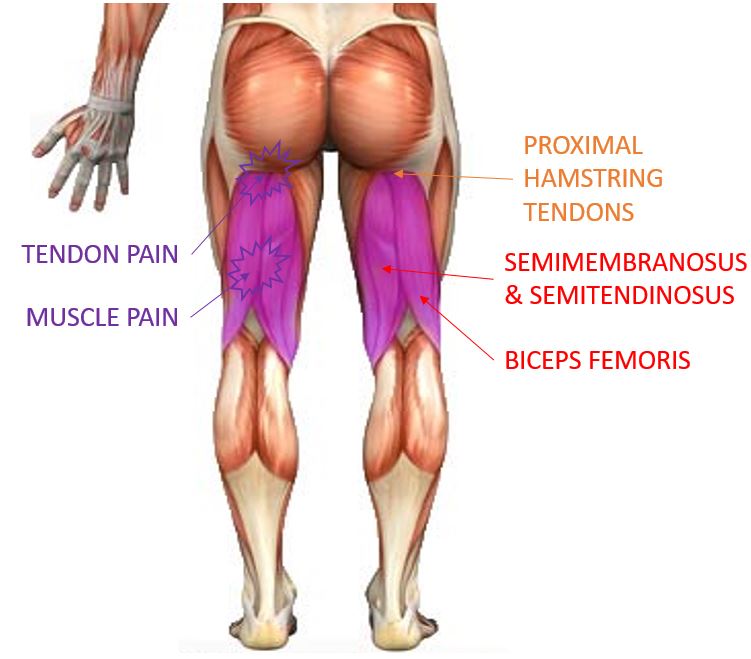
What is happening exactly – Tendon injury: The Proximal hamstring tendons are used in each stride during the walk, run, jumps or climbing. They are even used when we are standing. It is common that these tendons get irritated or inflamed. It is then an Proximal hamstring injury for the athlete.
The proximal hamstring tendons injury
symptoms and cause:
The Proximal hamstring tendons are getting painful after a run or sport activities. Generally, the pain appears after the run or the following morning, when the tendons are getting colder. Above all, the pain is at the top of the hamstring, close to the glutes. The pain, tenderness is more important in the morning, and improve with light activity.
Proximal hamstring tendonitis are caused by repetitive or intense strain on the hamstring tendons. In addition, these tendons are used in each stride. Usually, the cause for this injury are:
Overuse (increase the mileage of the intensity too fast).
Intense effort, with the muscle not warm enough.
Tight quads, putting tension on the hamstring.
Old running shoes which are loosing their support or foot protection.
Poor running form.
It is important to work on your form by doing drills before the speed session, strength and conditioning, warm-up correctly before each important session and increase the intensity or the mileage of your training progressivelly to allow the body to get stronger.
Diagnosis:
In other words, the pain is localized under the glutes, at the top of the hamstring. The pain is more important when the tendon is cold. Just by pushing with the tumb, you can feel pain in the tendon.
If the inflammation is important, you can even see that the skin is red and you may feel heat in the area.
The doctor may ask to get a Magnetic Resonance Imaging (MRI) in order to see better the damages on the tendons.
Treatment:
Firstly, reduce the inflammation using ice three to five times per day. Secondly, after fourty eight to seventy two hours, the inflammation should reduce.
A good way to reduce the pain is to avoid to walk, or reduce the stride length.
It is at this point that the physio will be able to start the treatment of the tendon in a very specific way.
The first treatment will be on the tendon directly with cross fiber deep massage. It will not be a very pleasant massage with some pain. In addition, the therapist may use needles to accelerate the healing.
The therapist should then work on both quads and glutes. Both may be tight, and have scare tissues to get rid off. A tight or shorter quad will mainly be the cause of the tendon to be put in tension.
The therapist can apply kinesiology tape between the glutes to the knee to support the tendon.
When going back home, the therapist will give you exercises and then ensure you spend time improving the situation by doing the exercises as specified. The use of ice after the exercises may avoid further inflammation.
Tips : Use a roller on your calves and quadriceps to improve the muscle suppleness.
The hamstring muscle injury / tear
symptoms and cause:
During a sprint or change of direction, you can feel a deep pain in the middle of the hamstring, at the back of the leg. It is a common injury for soccer players, or sprinters, but can happen to long distance runners during a speed session.
If the injury is important, you can even see the blood under the skin:
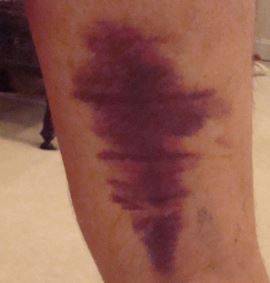
The hamstring muscle injury is caused by the elongation of the muscle during a big effort with the tear of the muscle. Usually, the cause for this injury are:
– The effort is done when the muscle is not warm enough.
– The hamstrings are already too long. There is an anterior tilt to the hips (it is due to tight quads and back, weak glutes and abdominals).
– Poor running form.
It is important to work on your form by doing drills before the speed session, strength and conditioning, warm-up correctly before each important session and increase the intensity or the mileage of your training progressivelly to allow the body to get stronger.
Diagnosis:
The pain is localized at the back of the leg, and you can feel the tear happening during the effort.
If the inflammation is important, you can even see blood just under the skin and you may feel heat in the area.
Treatment:
Firstly, reduce the inflammation using ice three to five times per day. After fourty eight to seventy two hours, the inflammation should reduce.
A good way to reduce the pain is to avoid to walk, or reduce the stride length.
It is at this point that the physio will be able to start the treatment of the muscle in a very specific way.
The first treatment will be on the muscle directly with cross fiber deep massage. It will not be a very pleasant massage with some pain. The use of needles may help to accelerate the healing.
The therapist should then work on both quads and back to remove tightness.
The therapist can apply kinesiology tape between the glutes to the knee to support the muscle.
When going back home, the therapist will give you exercises and then ensure you spend time improving the situation by doing the exercises as specified. The use of ice after the exercises may avoid further inflammation.
Tips : Use a roller on your back and quadriceps to improve the muscle suppleness.
Other Therapies:
However, other therapies may involve using shock waves, injections of corticosteroid directly in the tendons / muscles or a surgical treatment.
To lower the risk of the plantar fasciitis to happen, work on your strength and add the following to your training:
– 10 to 15 minutes of drills before each speed training session
– One session of plyometric per week
– hills repetitions (at the end of your easy days, 5 to 10 hills repetitions)
– Strength and conditioning (two sessions per week)
– Increase the training volume gradually, especially for master athletes
– Choose your shoes carefully
Preventing hamstring injuries
There have been many studies since the 90’s especially in soccer to avoid hamstring injuries.
Kristian Thorborg, Professor at the University of Copenhagen, has been studying hamstring injuries especially in Soccer. He published an article, in ’01, about a study on hamstring injuries. He defined a twelve weeks program to follow during winter with 5 sessions per week (twelve sets of six repetitions) : Hamstring lower program / Russian Hamstring.
Later, Roald Mjølsnes et al, completed further studies with the Iceland and Norway soccer national teams. They modified the twelve weeks Thorborg’s program to a 10 weeks program. This adapted program is more progressive and allow to avoid DOMS, but bringing similar results (no injuries in soccer players the following season).
Nordic program
This 10 weeks excentric hamstring strengthening training is very progressive. You need a friend / training partner to hold your feet in place. I advise to put a cushion under your knees.
The Nordic hamstrings exercise:
Subjects were instructed to let themselves fall forward, and then resist the fall against the ground as long as possible using their hamstrings.
The exercise is very simple. In the following video, you can see the details:
Training protocol for Nordic hamstring:
The 10 weeks program is progressively increasing the load and quantity:
| Week | Sessions per week | Sets and repetitions |
| 1 | 1 | 2 x 5 |
| 2 | 2 | 2 x 6 |
| 3 | 3 | 2 x 8 – 6 |
| 4 | 3 | 3 x 10 – 9 – 8 |
| 5-10 | 3 | 3 x 12 – 10 – 8 |
Load
Load is increased as subject can withstand the forward fall longer. When managing to withstand the whole Range Of Motion for twelve repetitions, increase load by adding speed to the starting phase of the motion. The partner can also increase loading further by pushing at the back of shoulders
After the 10 weeks plan, it is important to keep one / two sessions per week to keep the hamstring strength throughout the season.
Stretching
In the book, Clinical-Guide-Sports-Injuries, by Roald Bahr (Author), Sverre Maehlum (Author); there is a great stretch of the hamstring:
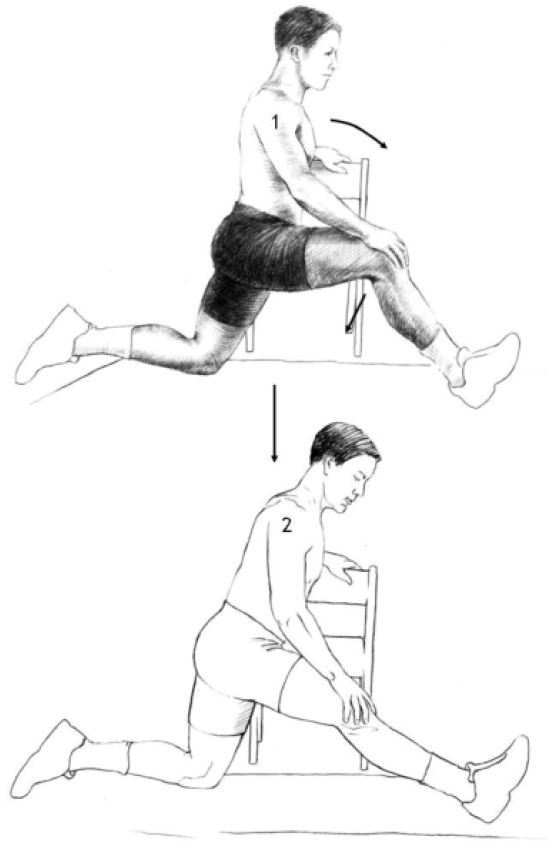
Warm-up stretching exercise: Use a support (chair or wall). Relax your ankle. Press your heel against the ground during ten seconds to activate the hamstring muscles.
Then relax and use your hand to straighten out your knee. Hold the stretch for about thirty seconds.
If necessary, bend forward slightly at your hip until you feel the stretch in the hamstrings, but be sure to keep your back straight. Stretch each leg three times before every training session throughout the season.
Flexibility training program
In the book, Clinical-Guide-Sports-Injuries, by Roald Bahr (Author), Sverre Maehlum (Author); there is a great flexibility training program of the hamstring:
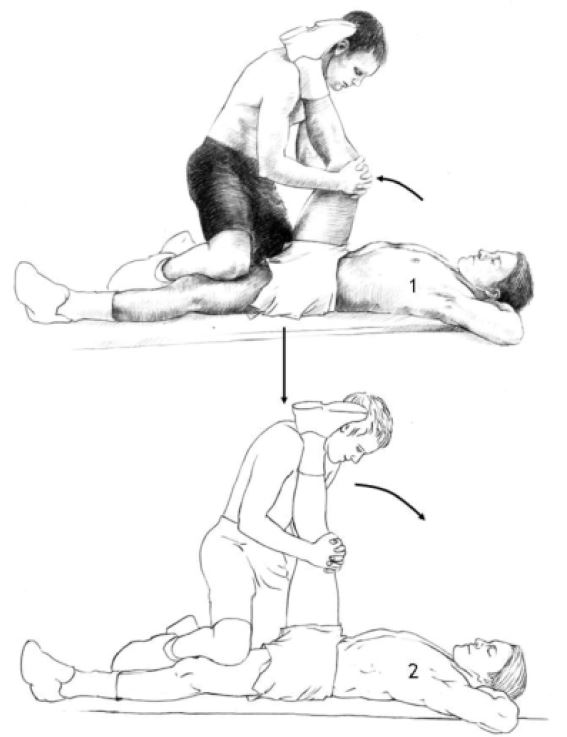
Flexibility training program: Your partner lifts your leg with the
knee slightly bent, until you feel stretching on the posterior
side of your thigh. Hold this position for a ten seconds
Press your leg against your partner’s shoulder, so
that your knee straightens out. Hold for ten seconds.
Then relax completely while your partner carefully stretches, by leaning forward. Hold that position for thirthy seconds
It is important to relax your ankle to stretch the posterior side of the thigh, not the lower leg.
Stretch each leg three times.
Tips: However, if you are on your own, use a rope under your foot and hold it with both hands.
